8180 can score as high as ~8300.
You're correct! Turns out a 2P Xeon 6168 system with 48C is already faster than AMD's 2P EPYC-7601 64C solution: 7212 pts vs 6879 pts
Follow along with the video below to see how to install our site as a web app on your home screen.
Note: This feature may not be available in some browsers.
8180 can score as high as ~8300.
i'm not familiar with the internals of Sandra, is the multimedia score a vector arithmetic test?
Don't know about the tea party, but I know someone registered in another forum to publicly bash Juan and praise a well-known AMD shill, informal (aka inf64). You know something is (mentally) wrong when you let me emotions take over and offend other people because of PC hardware. Funny that both of these stooges decided to buy a Haswell system at the end of the day.
Only 6174 CPUs. Over a Tflop sustained in Linpack per CPU
And those 24 cores is about what 64 EPYC cores does (2P 7601).
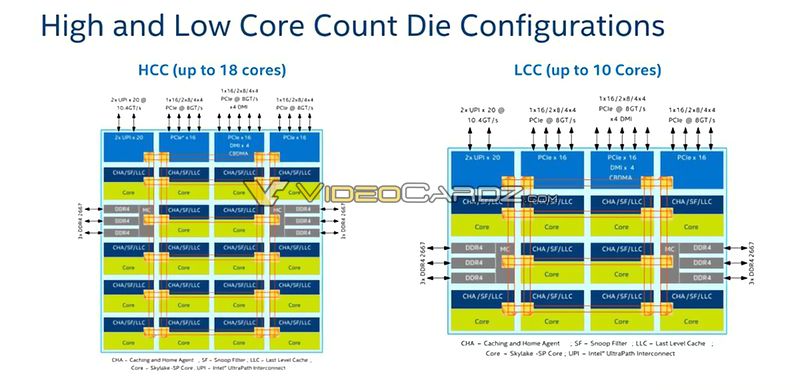
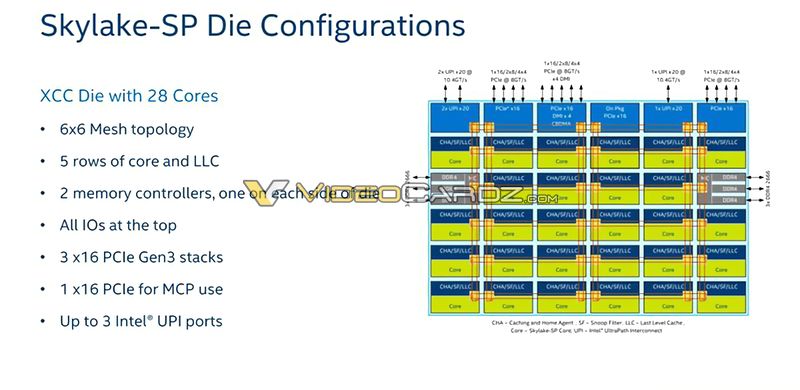
AnandTech said:For the EPYC launch, AMD sent us their best SKU: the EPYC 7601. Meanwhile Intel gave us a choice between the top bin Xeon 8180 and the Xeon 8176. Considering that the latter had 165-173W TDP, similar to AMD's best EPYC, we felt that the Xeon 8176 was the best choice.
I dunno, after half a decade out of the running AMD definitely needs some media support to get back going again, and I'm of the opinion the community should help support AMD where it's fair to breathe competition back into the high end.AT doesn't even try to be objective anymore. I would expect a so called journalist/writer for one of the most important tech websites to be at least somewhat less biased (looking at you Johan De Gellas).
Sure...
I dunno, after half a decade out of the running AMD definitely needs some media support to get back going again, and I'm of the opinion the community should help support AMD where it's fair to breathe competition back into the high end.
AT doesn't even try to be objective anymore. I would expect a so called journalist/writer for one of the most important tech websites to be at least somewhat less biased (looking at you Johan De Gellas).
Sure...
I think we can all agree that Epyc is hardly grade-C, with strong wins in general-purpose FP code and compilation, a slight lead in enterprise Java, good price/performance in data mining, and an abysmal loss in transactional databases. Skylake-SP is a much better workstation processor thanks to its aggressive turbo modes and better single-threaded performance, but for scale-out applications Epyc is a solid contender.Therefore if you and another person produce grade A and grade C products for sale --your being better because you did your work right-- you would ask us to ignore your product, because we would support the competition. Is that?
Skylake-SP is a much better workstation processor thanks to its aggressive turbo modes and better single-threaded performance.
Am I missing something?

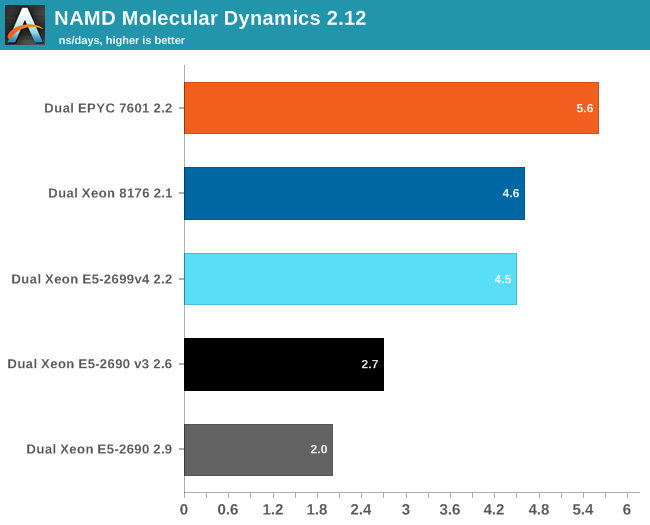
Why are AT results so much worse than other websites?
They even show a generational regression in terms of performance in POV-Ray while we know Skylake-X beats Broadwell-E here even with less cores...
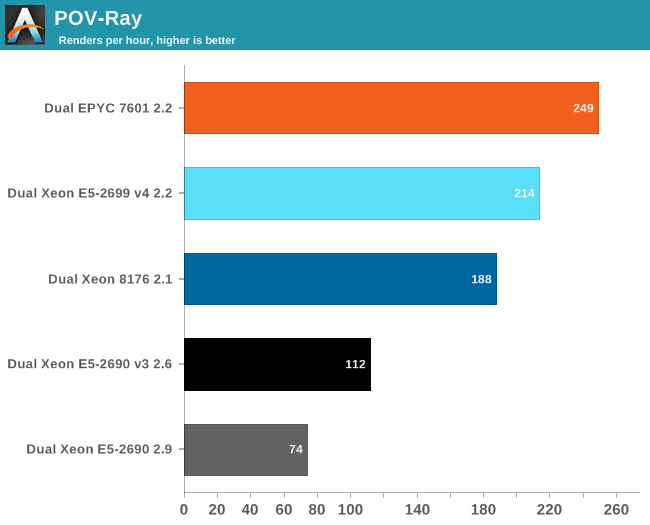
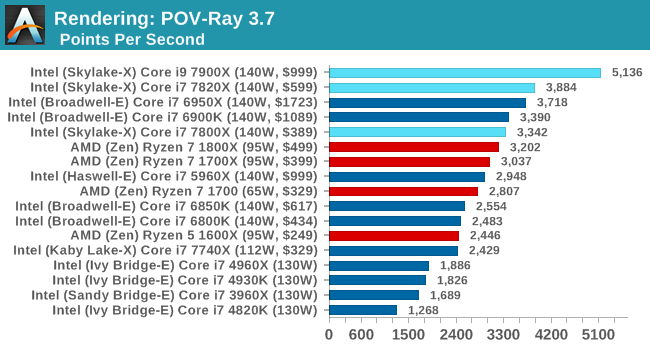
I think we can all agree that Epyc is hardly grade-C, with strong wins in general-purpose FP code and compilation, a slight lead in enterprise Java, good price/performance in data mining, and an abysmal loss in transactional databases. Skylake-SP is a much better workstation processor thanks to its aggressive turbo modes and better single-threaded performance, but for scale-out applications Epyc is a solid contender.
I wouldn't say misleading, they posted the numbers they got using their benchmarking methodology. A different version of NAMD, a different testcase, and a different kernel might swing results in Skylake's favor as the match is quite close; similarly, we could see a substantial increase in AMD's transactional database scores with more hand-tuning and a more favorable testcase (see, for example, this).It was only an illustrative example. Said that, AT review numbers are misleading.
amazing how shintai is still around after another meeh intel launch.
EPYC was nothing to write home about, but the Intel launch was even worst.
intel is basically charging 30-100% more money for 5-10% more raw performance and ~5% better power efficiency over their own last generation product. AMD has a cheaper product with quite decent performance and power profiles.
no matter how Shintai questions any given benchmark, i stand 200% behind AT review conclusion:
AMD IS PUTTING A LOT OF PRESSURE ON INTEL PRICES!.
The next conclusion: EPYC is a better enterprise CPU than Ryzen is a desktop CPU. And Ryzen captured 20% market share. Long live EPYC!
They better...because the Xeon Platinum og Gold CPU's are what we and our customers are looking at to purchase.
I have no knowledge about any AMD servers on the way into our datacenters.
.
TechPowerUp said:Ah, the "Glued-together" dies. Let's forget how AMD's Zen cores actually look like they were architected from the get-go for modularity and scaling, which has allowed the company to keep die-sizes to a minimum and yields to a maximum.
TechPowerUp said:So essentially, AMD has 8 more cores, 16 more threads, delivers 16% more performance than Intel's e5-2699 system and 32% more performance than Intel's "non glued-together" Xeon 8176. AMD's chip does all that while consuming 23% less power than the Xeon e5-2699, and 28% less than the Xeon 8176. Not too shabby. I'll take my CPUs with this kind of glue any day.
They had to pick the obviously crippled POV-Ray results where AT somehow managed to make a 28C Skylake-SP slower than 22C Broadwell-EP, while we know from their own (and other) Skylake-X reviews that a 7820X blows away a much more expensive 6950X with more cores in the same test.
https://www.techpowerup.com/235092/...cessors-glued-together-in-official-slide-deck

I agree. Launch was a big downer.amazing how shintai is still around after another meeh intel launch.
EPYC was nothing to write home about, but the Intel launch was even worst.
intel is basically charging 30-100% more money for 5-10% more raw performance and ~5% better power efficiency over their own last generation product. AMD has a cheaper product with quite decent performance and power profiles.
no matter how Shintai questions any given benchmark, i stand 200% behind AT review conclusion:
AMD IS PUTTING A LOT OF PRESSURE ON INTEL PRICES!.
The next conclusion: EPYC is a better enterprise CPU than Ryzen is a desktop CPU. And Ryzen captured 20% market share. Long live EPYC!
Fortunately we don't need to compare to LCC parts.
Hardware.info (POV-Ray 3.7)
Xeon 8180: 153,9 sec (lower is better)
Xeon E5-2699 v4: 221,4 sec
https://be.hardware.info/reviews/74...e-voor-servers-benchmarks-windows-server-2016
AnandTech (POV-Ray 3.7)

Massive performance per core regression? These are the results that TPU used in their 'article' and will certainly be quoted by the usual click bait websites later on.
amazing how shintai is still around after another meeh intel launch.
EPYC was nothing to write home about, but the Intel launch was even worst.
intel is basically charging 30-100% more money for 5-10% more raw performance and ~5% better power efficiency over their own last generation product. AMD has a cheaper product with quite decent performance and power profiles.
no matter how Shintai questions any given benchmark, i stand 200% behind AT review conclusion:
AMD IS PUTTING A LOT OF PRESSURE ON INTEL PRICES!.
The next conclusion: EPYC is a better enterprise CPU than Ryzen is a desktop CPU. And Ryzen captured 20% market share. Long live EPYC!
Right, let's completely ignore the fact that one Zeppelin die is 195 mm²,
They had to pick the crippled POV-Ray results where AT somehow managed to make a 28C Skylake-SP slower than 22C Broadwell-EP, while other websites show the new Xeon clearly ahead of its predecessor.
https://www.techpowerup.com/235092/...cessors-glued-together-in-official-slide-deck
I have no idea how or why AT would "obviously cripple" a POV-ray test result; the POV-ray benchmark is as easy as it gets to run, so short of outright lying the result is what it is.
Dot you think that 5% is an unattainable market share in the server market?I think exactly the contrary. Zen will sell better in desktop, thanks to fanboys and people that can be easily fooled by the usual biased reviews, whereas enterprise people are more difficult to fool because many test things by themselves.
And the claim that Ryzen captured 20% market share is wrong. RyZen impact is about 5%.
Dot you think that 5% is an unattainable market share in the server market?